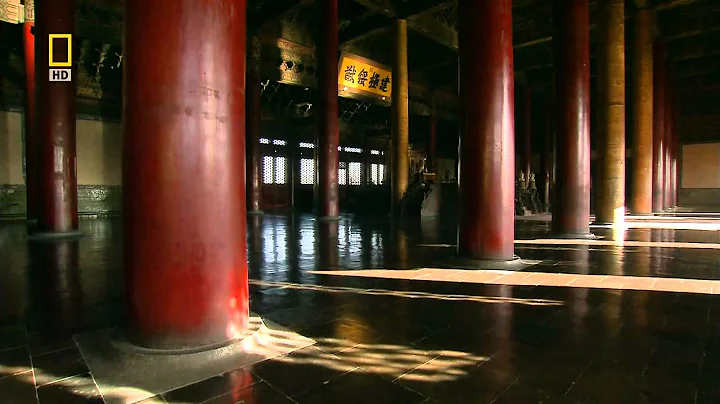
Afang Palace was built in the thirty-five years of Qin Shihuang (212 BC), together with the Great Wall, Qin Shihuang’s Mausoleum and Qin Zhidao, and was called the "Four Major Projects of Qin Shihuang".
The Chinese palace is a large-scale building complex inhabited by ancient Chinese emperors. It not only represents the highest status of imperial rulers, but also represents the highest level of traditional Chinese architecture. Chinese palaces are world-famous for their vast area, magnificence, and beautiful shapes, which are unmatched by any other civilized architecture. The Forbidden City is currently the most complete and largest palace complex in China, as well as the largest palace complex in the world. However, compared with other palaces that have existed in Chinese history, the Forbidden City can only be called a "miniature palace." Today, I will take stock of the top ten palaces in ancient China and appreciate the magnificent style of the palaces of the past dynasties in China.
10、Forbidden City
Dynasty: Ming, Qing
Area: 0.72 square kilometers
The Forbidden City in Beijing is the Ming and Qing Dynasties of China The Royal Palace, formerly known as the Forbidden City, is located in the center of the central axis of Beijing and is the essence of ancient Chinese palace architecture. The Forbidden City is 961 meters long from north to south, 753 meters wide from east to west, with a total area of 720,000 square meters and a building area of 150,000 square meters. The Forbidden City has more than 70 large and small palaces and more than 9,000 houses. It is one of the largest and best-preserved wooden structure ancient buildings in the world. The Forbidden City in Beijing, the Palace of Versailles in France, the Buckingham Palace in the United Kingdom, the White House in the United States, and the Kremlin in Russia are collectively known as the top five palaces in the world.
9, Xingqing Palace
Dynasty: Tang
Area: 1.3 square kilometers
One of the palace complexes (Tai Chi Palace, Daming Palace, Xingqing Palace), was originally the residence of Emperor Xuanzong of Tang Dynasty, and was expanded on a large scale after Emperor Xuanzong ascended the throne. However, at the beginning of his ascension, Emperor Xuanzong of Tang Dynasty advertised frugality, so although it has been expanded, it is not very large compared with the other two palaces. After the expansion is completed, Xingqing Palace will be 1080 meters from east to west and 1,250 meters from north to south, covering a total area of more than 1.3 million square kilometers.
After the Anshi Rebellion in the fifteenth year of Tianbao (755), Xingqing Palace lost its position as the center of political activities and became the home of the Supreme Emperor or Empress Dowager. At the end of Tang Dynasty, Chang'an City was destroyed, and Xingqing Palace was abandoned.
8, Daming Palace
Dynasty: Tang
Area: 3.2 square kilometers
Daming Palace, located in the north of Chang'an City, the capital of Tang Dynasty The dragon head on the side is the main hall of the Great Tang Empire, the political center and national symbol of the Tang Empire. Daming Palace was built in the eighth year of Emperor Taizong of the Tang Dynasty in Zhenguan. Since Gaozong of the Tang Dynasty, 17 emperors of the Tang Dynasty have handled government affairs here, which lasted more than two hundred years.
Daming Palace was the most magnificent and largest palace complex in the world at that time. Its architectural style influenced many countries around the Tang Empire. Daming Palace covers an area of 3.2 square kilometers, which is 4.5 times that of the Forbidden City in Beijing during the Ming and Qing Dynasties. It is known as the "Palace of Thousand Palaces" and the "Oriental Temple of the Silk Road". But unfortunately, in the third year of Emperor Zhaozong of Tang Dynasty, the Daming Palace was destroyed by the war in the late Tang Dynasty.

Beijing Imperial City in Ming Dynasty
057588d#9, Luoyang Gong05 Dynasty: Sui, Tang
Area: 4.09 square kilometers
Luoyang Palace went through the Sui and Tang dynasties, and was called "Purple Palace" in Sui Dynasty, Tang Taizong was named "Luoyang Palace" and Wu Zetian At that time, it was called "Taichu Palace". In the Tang Dynasty, Luoyang Palace basically followed the structure of the Sui Dynasty. There were twelve gates around twelve miles around, but the name of the city gate was changed. Xianqing two years,Tang Gaozong officially designated Luoyang as the eastern capital, and Luoyang Palace became the royal palace. After Empress Wu Zetian ascended the throne and became emperor, she even regarded Luoyang as the capital of the empire, called the capital of God. With the comprehensive eastward movement of the political, economic, and cultural centers of the Tang Dynasty, the Luoyang Palace was continuously expanded and renovated, reaching its peak in scale and magnificence. At its peak, the Luoyang Palace had a total area of about 4.09 square kilometers, equivalent to about the size of six Forbidden City.
6, Taiji Palace
Dynasty: Sui, Tang
Area: 4.2 square kilometers
Taiji Palace, built in Sui In the second year of Emperor Wen Kaihuang (582), the Sui Dynasty was called Daxing Palace, and in the first year of Tang Ruizong Jingyun (710), it was renamed Taiji Palace. The Taiji Palace site is located in the core area of Xi'an City. It is covered by modern buildings and has no conditions for archaeological excavation. According to literature records and surveys, Tai Chi Palace is 2830 meters wide from east to west, 1492 meters long from north to south, 10.3 meters high, and wall base thickness is 14-18 meters. From these data, we can imagine the grandeur of Tai Chi Palace. There are many famous palace buildings in Tai Chi Palace, such as Tai Chi Hall, Liangyi Hall, Chengqing Hall, Wude Hall, Ganlu Hall, Lingyan Pavilion and so on.
5, Weiyang Palace
Dynasty: Han
Area: 5 square kilometers
Weiyang Palace is the main hall of the Western Han Empire , Built in the 7th year of Emperor Gaozu of the Han Dynasty (200 BC), on the basis of Qinzhangtai. It is located on the Longshouyuan in the southwest corner of Chang'an City, the highest terrain in the Han Dynasty. Called West Palace.
Since Weiyang Palace was built, the emperors of the Western Han Dynasty lived here and became the center of government orders for the Han Empire for more than two hundred years. Therefore, in the poems of later generations, Weiyang Palace has become synonymous with Han Palace. After the Western Han Dynasty, Weiyang Palace was still the governing place of many dynasties. It survived 1041 and was the palace with the most dynasties and the longest existence in Chinese history. Weiyang Palace is one of the largest palace complexes in ancient China. Its architectural form has profoundly influenced the palace architecture of later generations and laid the basic pattern of palace architecture in China for more than two thousand years.

Beijing Imperial City plane during the Ming Dynasty, Beijing Imperial City plane during the Qing Dynasty
Dynasty: Han
Area: 5 square kilometers (slightly larger than Weiyang Palace)
Jianzhang Palace was built in the early Yuan Dynasty of Emperor Wu of the Han Dynasty In the year (104 BC), in order to show the prestige and prosperity of the Han Dynasty, his "duality is greater than Weiyang" and bigger than Weiyang Palace, and it is known as "tens of thousands of families". For the convenience of communication, Emperor Wu built Fei Pavilion Road across the city, but he never went to the Palace of the Yangtze Palace until the Palace of the Jianzhang. "Sanfu Huangtu" contains: "There are thousands of households for more than 20 li in the week, in the west of Weiyang Palace and outside Chang'an City." Jianzhang Palace was finally destroyed by Wang Mang at the end of Han Dynasty.
3, Changle Palace
Dynasty: Han
Area: 6 square kilometers
Changle Palace is the first formal palace in the Western Han Dynasty , Built on the basis of Qin Xingle Palace, was built in the fifth year of Emperor Gaozu of Tang Dynasty (202 BC), and together with Weiyang Palace and Jianzhang Palace became the three palaces of the Han Dynasty, and it is also the largest palace among them. According to archaeological findings, it is 2900 meters long from east to west, 2400 meters wide from north to south, and 10.6 kilometers in circumference. The total area is 6 square kilometers, which is equivalent to the size of 8 Forbidden City.
2, Afang Palace
Dynasty: Qin
Area: 15 square kilometers
The Afang Palace was built in the 35th year of Qin Shihuang (212 BC), together with the Great Wall, the Mausoleum of Qin Shihuang and Qin Zhidao, they are called the "Four Major Projects of Qin Shihuang". They are the first unified landmarks in China. In 1992, a UNESCO site visit confirmed that the architectural scale and integrity of the Qin Afang Palace site ranks first among the world's ancient buildings. It is one of the world's miracles and famous sites, and is known as the "first palace in the world." The Afang Palace is not only the most glorious and magnificent palace complex in Chinese history, but also records the history of China's transition from decentralization to unity, and bears the glorious mark of Chinese civilization.

During the process of Qin Shihuang's unification of the Six Kingdoms, Xianyang Palace continued to expand
055881, Xianyang Palace
Dynasty: Qin
Area: unknown (about 2000 times the Forbidden City)
Originally Xianyang Palace was located on the northern terrace of Xianyang City, the capital of Qin Dynasty. During the process of Qin Shihuang's unification of the six countries, continuous expansion was carried out. "Historical Records-The Book of Qin Shi Huang" records that in the process of Qin Shi Huang's unification of the country, "every time he breaks the princes, write his palaces", that is, every time Qin destroys a country, he must imitate the palace of that country and expand the palace on Xianyang Plain. On the north bank of the Weishui River, 145 palaces and 270 palaces have been built such as the “Six Kingdoms Palaces” with their own characteristics, such as “Jique”, “Ganquan Palace” and “Shanglin Garden”. The palaces are connected by complex roads and corridors to form a prosperous metropolis.
In addition to the main hall of Xianyang Palace, there are also three hundred Ligong Gardens around Xianyang. The "Book of Han" contains: "Qin starts from Xianyang, west to Yong, and three hundred Ligong"; "Historical Records" says: " Within two hundred miles next to Xianyang, the palace is 270". Its scope covers the four cities of Baoji, Xianyang, Xi'an and Weinan today. These Ligong Pavilions are connected by various complex roads, corridors, pavilion roads, etc., to form a large closed circle, forming the Xianyang Palace in a broad sense, with a diameter of more than 80 kilometers, and its area is equivalent to nearly a hundred times that of Han Chang’an City. More than two thousand times the Forbidden City.
Xianyang Palace is one of the most magnificent palaces in Chinese history. Its scale is unprecedented, but it is too expensive. At the end of the Qin Dynasty, Xiang Yu invaded Xianyang and set fire to it. Most of the Xianyang Palace was reduced to rubble.
At present, some scholars believe that simply comparing the Forbidden City to the Daming Palace in the Tang Dynasty and the Weiyang Palace in the Han Dynasty is not rigorous, but should be compared with the inner city of Beijing or the imperial city, but there is no scientific conclusion yet.





















